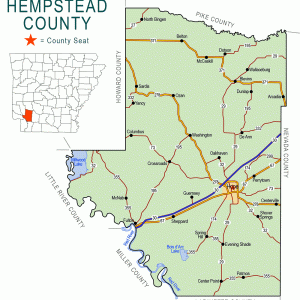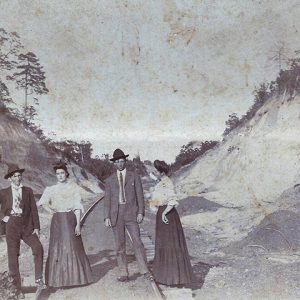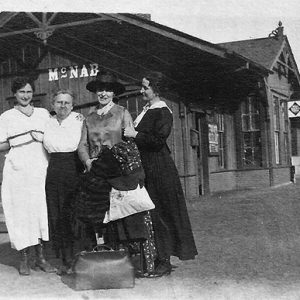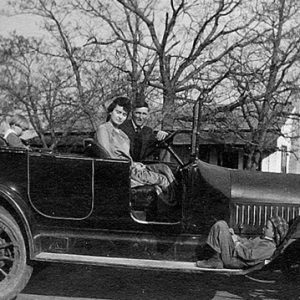calsfoundation@cals.org
McNab (Hempstead County)
| Latitude and Longitude: | 33°39’40″N 093°49’58″W |
| Elevation: | 318 feet |
| Area: | 0.34 square miles (2020 Census) |
| Population: | 30 (2020 Census) |
| Incorporation Date: | March 20, 1909 |
Historical Population as per the U.S. Census:
|
1810 |
1820 |
1830 |
1840 |
1850 |
1860 |
1870 |
1880 |
1890 |
1900 |
|
– |
– |
– |
– |
– |
– |
– |
– |
– |
– |
|
1910 |
1920 |
1930 |
1940 |
1950 |
1960 |
1970 |
1980 |
1990 |
2000 |
|
271 |
147 |
223 |
144 |
206 |
142 |
– |
– |
95 |
37 |
|
2010 |
2020 |
|
|
|
|
|
|
|
|
|
68 |
30 |
|
|
|
|
|
|
|
|
McNab is a town on State Highway 355 in western Hempstead County. Created as a railroad depot, McNab is known in the twenty-first century for its Twin Rivers Festival, held every April.
Caddo Indians inhabited the Red River valley when French and Spanish explorers first arrived in the region. Shortly after the Louisiana Purchase of 1803, a boat landing and settlement named Fulton (Hempstead County) arose on the Red River. Settlers came to the town by boat or by land using the Southwest Trail, a military road that ended at Fulton. Some settlers cleared land a few miles north of Fulton, where the town of McNab would later appear. William McElroy and Thomas Reed both acquired land patents in the vicinity of McNab in 1837, and Gideon Crews received a land patent in the same area in 1860.
In 1902, a group of investors formed the Arkansas and Choctaw Railroad to connect the city of Hope (Hempstead County) with Ardmore, which was then in Indian Territory (now Oklahoma). By the time the rails were laid in 1903, the company had reorganized as the St. Louis, San Francisco and New Orleans Railroad; the next year, it became part of the St. Louis–San Francisco Railway Co., also known as the Frisco. A railroad depot was built on the land of farmer Charles McNab, and the post office that opened in the depot in 1903 was called McNab.
As was the case with many other railroad depots, a community began to form around the McNab depot and post office. The town was incorporated in 1909. By 1912, McNab had three general stores, run by Barnes and Brothers, the Cannon Brothers, and W. B. Lancaster. The town was also home to physician J. H. Shelton and C. C. Hindman, who was both a blacksmith and a grocer. The Hope Lumber Company also had an office in McNab, and lumbermen were likely included among the citizens of the new town.
Over the years, the population of the town fluctuated, exceeding 200 residents in 1910, 1930, and 1950. The use of diesel railroad engines rather than steam locomotives after World War II made the railroad depot in McNab unnecessary. In 1970 and 1980, no census records were reported for McNab, suggesting that the town lost its incorporation during that time period. The construction of Millwood Lake and Dam on the Little River upstream from McNab between 1961 and 1966 may have had a negative impact upon the town. By 1990, McNab had reincorporated with ninety-five residents, and although the population dropped to thirty-seven in 2000, it had grown to sixty-eight by 2010.
In 2002, the town of McNab organized its first Twin Rivers Festival, named for the Little River and the Red River. The annual festival, held in April, features arts and crafts, food booths, antique cars and trucks, an auction, a dance show and talent show, a parade, and an outdoor church service.
In December 2012, the John W. Turk Power Plant began operating between McNab and Fulton. It belongs to the Southwestern Electric Power Company (SWEPCO) and employs more than 100 people. It burns coal to produce steam that results in a capacity of 600 megawatts of electrical power for customers in Arkansas, Louisiana, and Texas.
The population of sixty-eight citizens of McNab counted in 2010 included forty-one African-American residents and twenty-two white. There are two churches in the town. Children in McNab attend the schools in Hope.
For additional information:
“Twin Rivers Festival Slated.” Hope Star, June 16, 2015. Online at http://www.hopestar.com/article/20150616/NEWS/150619763 (accessed June 29, 2022).
Steven Teske
Butler Center for Arkansas Studies
 Hempstead County Map
Hempstead County Map  McNab Family Home
McNab Family Home  Near McNab
Near McNab  McNab Scene
McNab Scene  McNab Depot
McNab Depot  McNab Home
McNab Home 




My father Ralph Erwin was born and raised in McNab, AR. His parents were Charles Wesley Erwin and Reba Howard Erwin. He graduated from Saratoga High School and moved to Mobile, AL, where he lived the rest of his life. He had two brothers, Howard and Edward, and two sisters, Ernestine and Bonnie. Our Aunt Bonnie, the last surviving member of that generation, just passed earlier this year. My grandmother died in 1978 when I was ten, but I have good memories of visiting her home in McNab and summer evenings on her front porch laughing with our aunts, uncles, and cousins.
I am 72, retired, and live in Montana. But I was born and raised in Texarkana and am interested in the local history of the area where I was born and my family comes from. My great-great-grandfather, Charles McNab (1811-1883), emigrated from Scotland in 1836 and settled in Summergrove, DeSoto parish, Louisiana, in 1844. He bought land along Red River in Hempstead and Miller counties before the Civil War and had about a thousand acres there by 1880. He died in 1883 on the family place at what came to be called McNab. My father and grandfather were born McNab, Arkansas, my grandad in 1884 and my dad in 1915. Gideon Crews–mentioned in this article–was my great-great-grandfather. His daughter, Mattie Elizabeth (my great-grandmother), married Charles F. McNab (1858-1916)–also mentioned in the article–on whose land the old McNab railroad depot was built. She also served as postmistress for a while.